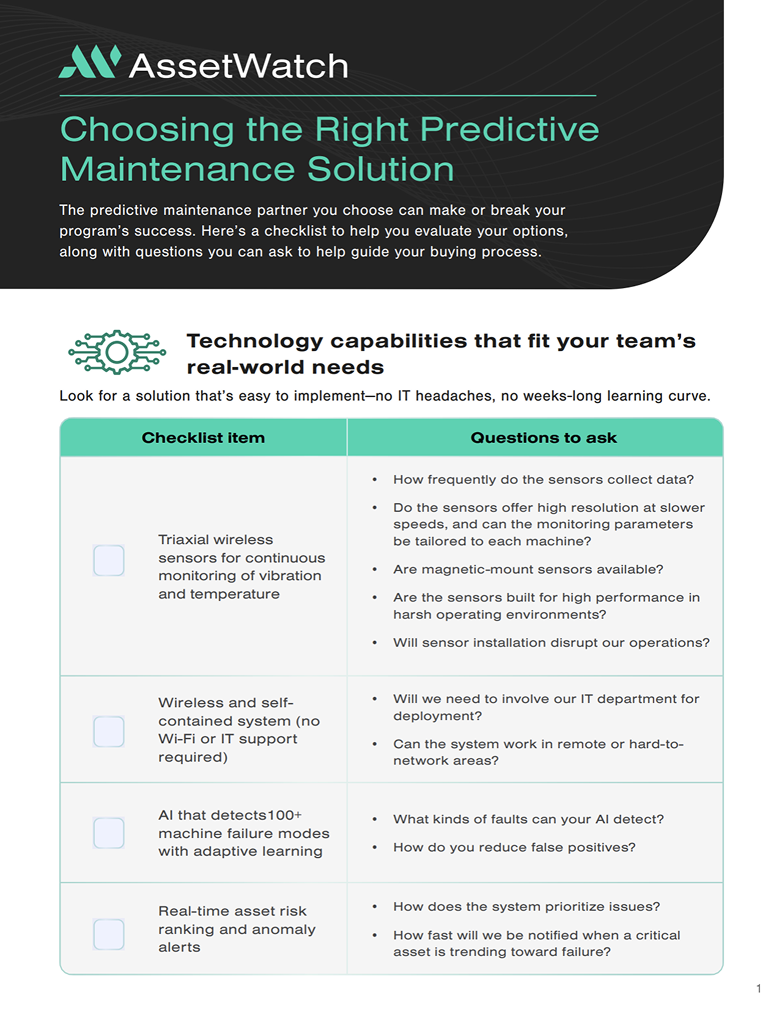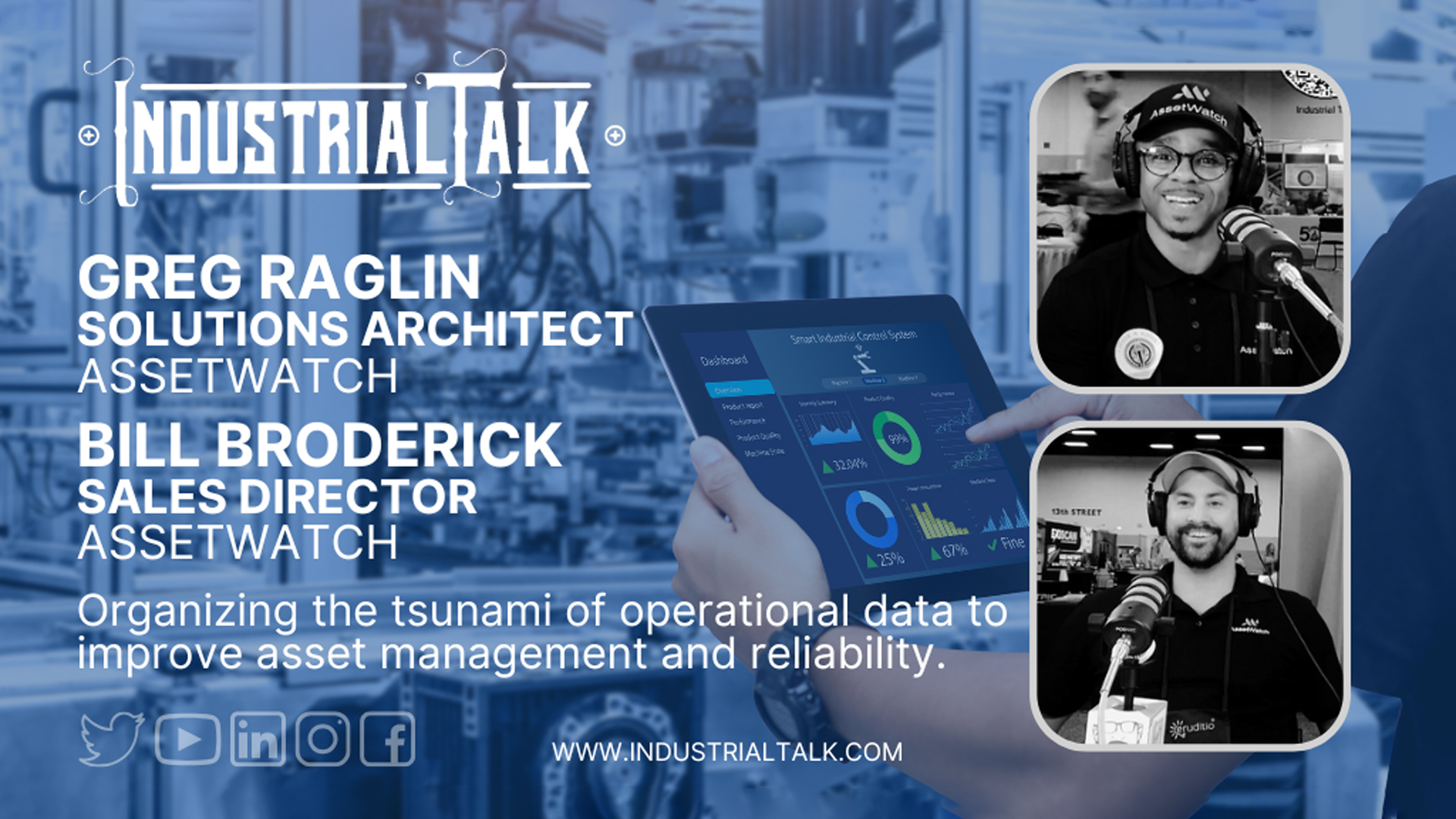To move from chaotic emergency repairs to calm, easy downtime prevention shouldn't be a Herculean feat. Vibration sensors, oil analysis, and predictive maintenance (PdM) technologies can make life a lot simpler—as long as you have solid support from dedicated experts who can help your team adjust, help them make sense of condition monitoring data, and point them toward corrective actions day to day.
With those pieces in place, you'll be set for success. But before the first sensor is in place, you'll need a well-laid plan. You don’t want to waste time, budget, or credibility on a pilot that fizzles.
This post can help. It's a practical, step-by-step predictive maintenance checklist you can use to plan, execute, and optimize your pilot program so your team can leave reactive maintenance behind and unlock their true predictive power.
Your guide to getting started with a predictive maintenance program
- Why launch a predictive maintenance pilot program?
- How do you choose the right assets to monitor?
- What data should you track?
- How do you secure team buy-in for your pilot?
- What equipment and sensor setup do you need?
- Why is expert analysis critical for your pilot program?
- Why integrate your pilot with CMMS?
- How do you track ROI and prove the value of a predictive maintenance approach?
- How do you plan for scale after the pilot?
Why launch a PdM pilot program?
Unplanned downtime is one of the costliest problems in manufacturing. A reactive maintenance strategy is notoriously inefficient—not to mention a major source of stress for facility teams. A predictive maintenance program will enable you to detect potential issues early so you can avoid catastrophic failures, streamline maintenance, and maintain peak asset health, performance, and reliability.
The benefits of predictive maintenance are far reaching. But going plant-wide immediately can be risky, expensive, and overwhelming. That’s why starting with a pilot program is smart.
Benefits of a pilot:
- Test and prove predictive maintenance ROI
- Build internal confidence
- Identify best practices for your facility
- Show management measurable value before scaling
Your pilot is your low-risk way to validate predictive maintenance as a less costly, more effective strategy than reactive or even preventive maintenance.
The best PdM pilot offers all the benefits of predictive maintenance, starting on day one, with the least amount of risk. A cement manufacturer realized over $1 million in savings in just six months of service—with install, hardware, software, and support included at no extra cost. Read their story here.
How do you choose the right assets to monitor?
Real-time condition monitoring should be reserved for equipment you can't afford to let fail. Here are some tips for determining which assets to include in your pilot program.
✅ Prioritize assets with:
- High maintenance costs or downtime impact
- History of equipment failure
- Long lead times for repairs
- Critical role in production
✅ Consider these factors:
- Past maintenance history
- Safety and regulatory impact
- Value of reduced downtime on production schedules
If you try to monitor everything, you won't see as great a return. Focus on critical assets where early detection delivers the biggest payoff.
What data should you track?
Going from a reactive to a data-driven approach will give you a more complete picture of asset health—allowing you to identify root causes more easily, minimize wear and tear through early resolution of issues, and extend the lifespan of your equipment.
Here are the types of data you'll be factoring into your new maintenance routine:
- Vibration data
- Temperature data
- Oil analysis results
- Lubrication schedules
- Historical maintenance records
- Failure modes and critical thresholds
Tracking multiple indicators of asset health, both historical and real time, is key to ensuring the success of your pilot program. It also helps to track actionable KPIs (average response and repair times, for example) so you can refine maintenance processes as needed. As decision making improves, your team can eliminate costly disruptions, optimize maintenance planning and resource allocation, and maximize the value of your assets.
How do you secure team buy-in for your pilot?
Even the best predictive maintenance program fails without buy-in from maintenance personnel, operators, and leadership. With new technologies in play, resistance at the plant level can be tough to overcome without a thoughtful approach and clear proof of value.
Your pilot "preflight" checklist should include steps to:
- Explain benefits of predictive maintenance in simple, clear terms
- Show how it reduces unplanned downtime, improves efficiency, and simplifies asset management
- Address fears of data overload or extra workload
- Emphasize simpler work and reduced firefighting
When your team feels ownership, along with robust provider support, your pilot’s chance of success skyrockets. Your expert partner can work closely with your team from day one, helping them determine criticality of assets, learn the new system, and interpret early results. In most cases, early asset saves will put any remaining uncertainty to rest.
What equipment and sensor setup do you need?
A PdM program relies on Internet of Things (IoT) sensors, AI-powered analytics, and machine learning, with a dedicated expert supporting the team on an ongoing basis. When comparing solutions, opt for a full-service provider that will make setup and adoption easy.
✅ Select sensor types—Wireless triaxial vibration sensors offer many advantages including high resolution at slower speeds and a durable design.
✅ Consider your current setup—Choose predictive maintenance software that integrates easily with your CMMS and other existing systems so your team can automate basic tasks and collaborate more effectively.
✅ Plan installation—Your vendor can walk you through this process, starting with the criticality assessment, and take care of the sensor install and system setup (included as part of your PdM service) so you're up and running in 1-2 days.
Why is expert analysis critical in your pilot program?
Raw data isn’t enough. False positives can lead to alert fatigue, with the team scrambling to troubleshoot and resolve nonissues while critical issues are left unaddressed. With no way to prioritize maintenance needs, efficiency and productivity suffer. As wear and degradation worsen, overall equipment effectiveness suffers as well.
A condition monitoring engineer (CME), who's dedicated to your facility, can validate AI-generated alerts, provide prescriptive recommendations, and help prioritize maintenance activities. Your team can be confident they're focusing on real issues, optimizing both maintenance efficiency and equipment reliability.
Having a dedicated human in the loop—a CAT III+ vibration analyst who filters out false positives and guides facility teams to corrective actions—is a key differentiator that separates best-in-class predictive maintenance providers.
Why integrate your pilot with CMMS?
Your predictive maintenance pilot should integrate seamlessly with your current setup so your team can make best use of the data—not just to prevent equipment failures, but to enhance operational efficiency and optimize asset health.
✅ Basic functionality
- Link real-time monitoring to maintenance management software
- Create automatic work orders from predictive alerts
- Track maintenance records and history
✅ Essential capabilities
- Complete visibility into maintenance operations
- Work order management simplified, with no discrepancies, errors, or delays
- Seamless communication across maintenance teams and with your CME
A CMMS integration turns data into action. It's essential for PdM pilot success and increasing ROI in the future. Your team will be able to respond to maintenance needs quickly and effectively while making strategic decisions that will have a broader impact on your operations.
How do you track ROI and prove the value of a predictive maintenance approach?
A pilot program must show measurable value, starting with lower maintenance costs. When you can prove ROI, you'll make believers out of your facility teams. You'll also make it easy to get management buy-in to scale.
Here are some examples of KPIs you can use to calculate the value of your PdM pilot.
✅ Cost savings and ROI
- Total cost of maintenance
- Decrease in emergency repairs
- Reduction in overtime labor
✅ Equipment performance and reliability
- Mean time between failures (MTBF)
- Mean time to repair (MTTR)
- Reduction in unplanned downtime
✅ Production and operational efficiency
- Overall equipment effectiveness (OEE)
- Throughput increase
- Reduction in maintenance-related production delays
Looking for a complete list of KPIs covering a full spectrum of organizational goals? Check out our predictive maintenance KPI checklist for metrics across seven categories, complete with formulas you can use to measure your progress. Download your copy today.
How do you plan for scale after the pilot?
The goal of your predictive maintenance pilot program is twofold: 1) to establish a blueprint for a full-scale predictive maintenance strategy; and 2) to achieve sustainable transformation. Here's how you can do both.
✅ Document what worked
- Best practices
- Lessons learned
- Equipment performance improvements
✅ Update your predictive maintenance checklist for broader rollout
✅ Get buy-in for expanding to additional assets or facilities
✅ Plan training and support for maintenance personnel
With a deep understanding of your operations, your dedicated support team can help facilitate a smooth expansion and ensure all stakeholders have the training, information, and guidance they need to proceed with confidence.
The step-by-step plan to optimize your PdM pilot
- Monitor critical (Tier 1) assets with the biggest impact on production
- Use real-time condition monitoring with advanced sensors
- Partner with your CME to avoid alert fatigue, prioritize maintenance tasks, and resolve issues quickly
- Integrate with your CMMS for seamless maintenance management
- Prove ROI to secure buy-in for scaling
- Continuously refine your approach for better results
Learn how easy it is to implement predictive maintenance for the first time
Ready to launch a predictive maintenance pilot that actually delivers?
Book some time with an AssetWatch expert. We'll help you plan, install, monitor, and optimize your pilot program so you can avoid the usual pitfalls. Starting on day one, you'll be able to reduce downtime, lower costs, and build the business case you need to scale.
Schedule your free consultation today, and start turning your maintenance challenges into success stories.




.avif)













